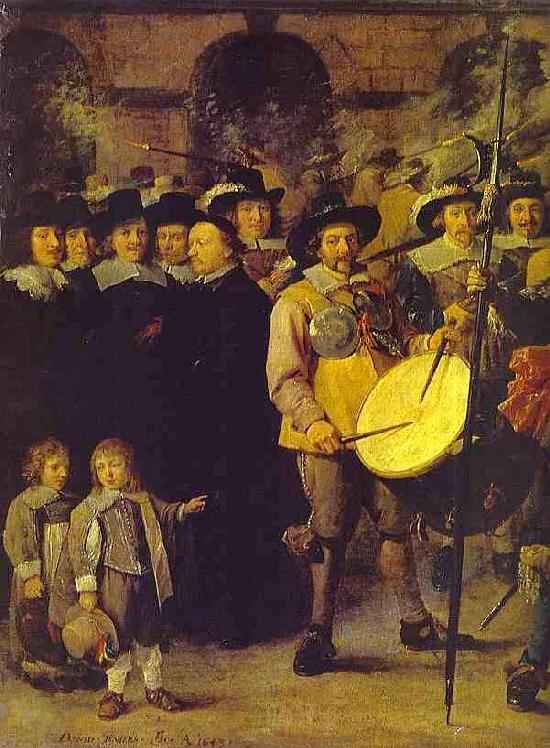
Artists Illustrating Boys' Fashions: David Teniers the Younger (Flanders, 1610-90)

Figure 1.--Here we have one of Teniers' paintings, "Members of Antwerp
Town Council and Masters of the Armaments Guild", dated 1643, located at the Hermitage, St. Petersburg, Russia. We are not sure what is going on, but the drumer seems to be marshalling troops and there is fighting going on in the background. Thiswould have been during the 30 Years War.
|
Flemish artist David Teniers the Younger was both a painter and engraver. He was born in Antwerp during 1610. He is noted for his genre paintings depicting daily life in the 17th century. He is the best known of the artists in his extended family. He studied art as a boy for many years under his father David Teniers the Elder. Stangely, art experts suggest that his father does not seem to have greatly influenced his son's style. One of his earliest works was the “The Five Senses” (1635). An influence on Teniers was was Dutch artist Adriaen Brouwer who is known for his peasant scenes rather than the genteel depiction of middle-class life often favored by Flemish artists. Other Dutch artists were also influential. Teniers' “The Barn” is a good example of the early phase of his work. Teniers married the daughter of Jan Breughel the Elder (1637). Teniers also knew Rubens who was his wife's guardian and served as a witness at their wedding. Teniers' father-in-law proved to be a strong influence in his art. His genre scenes gradually became more genteel. He became one of the Flemish masters at depicting everyday life. An excellent example is the “Village Fete” (1646). Like other Flemish genre artists, Teniers also did a number of works with religious and mythological themes as well as landscapes. Teniers eventually received an appointment to the court of Archduke Leopold William in Brusseles (1651). Spain had been able to maintain its control over Flanders in the Dutch War for Independence. Leopold William was the governor of the Spanish Netherlands. Here he served as court painter. But he had others duties, including tapestry designer, art curator, and gentleman-in-waiting to the Archduke. His career and appointment to the Archduke's court brought his considerable wealth. He was even awarded a patent of nobility.
Parents
Childhood
Education
David studied art as a boy for many years under his father David Teniers the Elder. Stangely, art experts suggest that his father does not seem to have greatly influenced his son's style.
Career
Flemish artist David Teniers the Younger was both a painter and engraver. He was born in Antwerp during 1610. He is noted for his genre paintings depicting daily life in the 17th century. He is the best known of the artists in his extended family. One of his earliest works was the “The Five Senses” (1635). Another influence on Teniers was was Dutch artist Adriaen Brouwer who is known for his peasant scenes rather than the genteel depiction of middle-class life often favored by Flemish artists. Other Dutch artists were also influential. Teniers' “The Barn” is a good example of the early phase of his work. His genre scenes gradually became more genteel. He became one of the Flemish masters at depicting everyday life. An excellent example is the “Village Fete” (1646). Like other Flemish genre artists, Teniers also did a number of works with religious and mythological themes as well as landscapes. Teniers eventually received an appointment to the court of Archduke Leopold William in Brusseles (1651). This was only 3 years after the end of the 30 Years War. Leopold William was the governor of the Spanish Netherlands. Here he served as court painter. But he had others duties, including tapestry designer, art curator, and gentleman-in-waiting to the Archduke. His career and appointment to the Archduke's court brought his considerable wealth. He was even awarded a patent of nobility.
Political Background
Spain had been able to maintain its control over Flanders in the Dutch War for Independence. As a result today the Netherlabds is Protestant and Belgiym Ctholic. Tiniers childhood and early carrer ocurred during the Dutch War for Independence and the 30 Years War (1618-1648). These were dreadful wars and large areas of the Low Lands were devestated. The religious issue made the fighting especially dreadful for civilians who were often targetted. Germany did not recover for generations.
Family
Teniers married the daughter of Jan Breughel the Elder (1637). Teniers also knew Rubens who was his wife's guardian and served as a witness at their wedding. Teniers' father-in-law proved to be a strong influence in his art.
Clothing
Like other genre painters, Teniers' work provides a great deal of information on clothing. Notice the two children at the left. They could be a boy and girl, but I suspect that the younger child is a boy who had not yet been breeched.
A reader writes, "The painting by David Teniers the Younger appears to show a shoe with two bars. The handle of a spear held by another person goes right across the shoe making it hard to assess the style. It could be the earliest
image of two bar shoes I have seen." We note that strap shoes in general, however, were a style commonly worn by both men and boys during the Renaisance.
HBC

Navigate the Boys' Historical Clothing Artists pages:
[Return to Main Flemish artist page]
[Return to Main Artists S-Z page]
[Chronology]
[Countries]
[Individuals]
[Styles]
Navigate the Boys' Historical Clothing Web Site:
[Introduction]
[Activities]
[Biographies]
[Chronology]
[Clothing styles]
[Countries]
[Bibliographies]
[Contributions]
[FAQs]
[Glossaries]
[Satellite sites]
[Tools]
[Boys' Clothing Home]
Created: September 6, 2002
Last updated: 11:13 PM 11/12/2005



